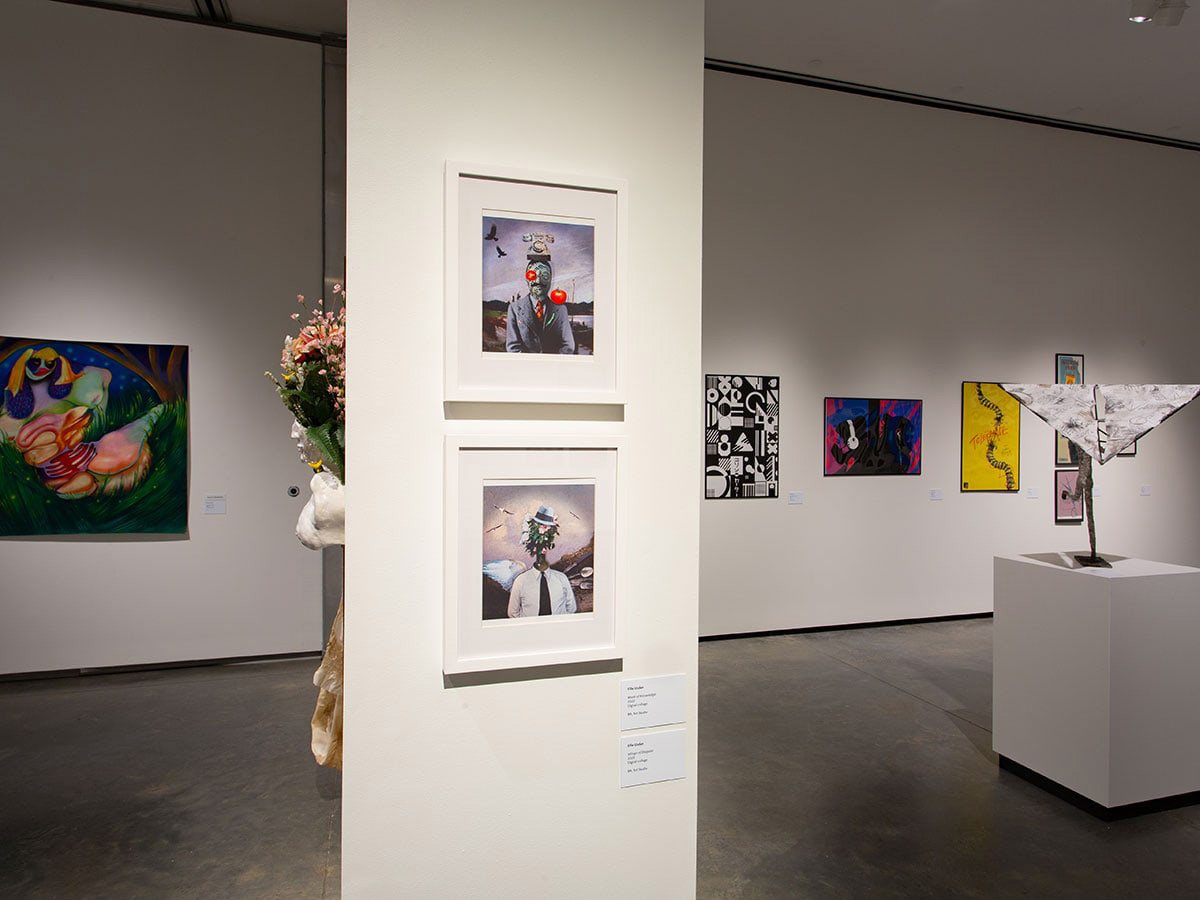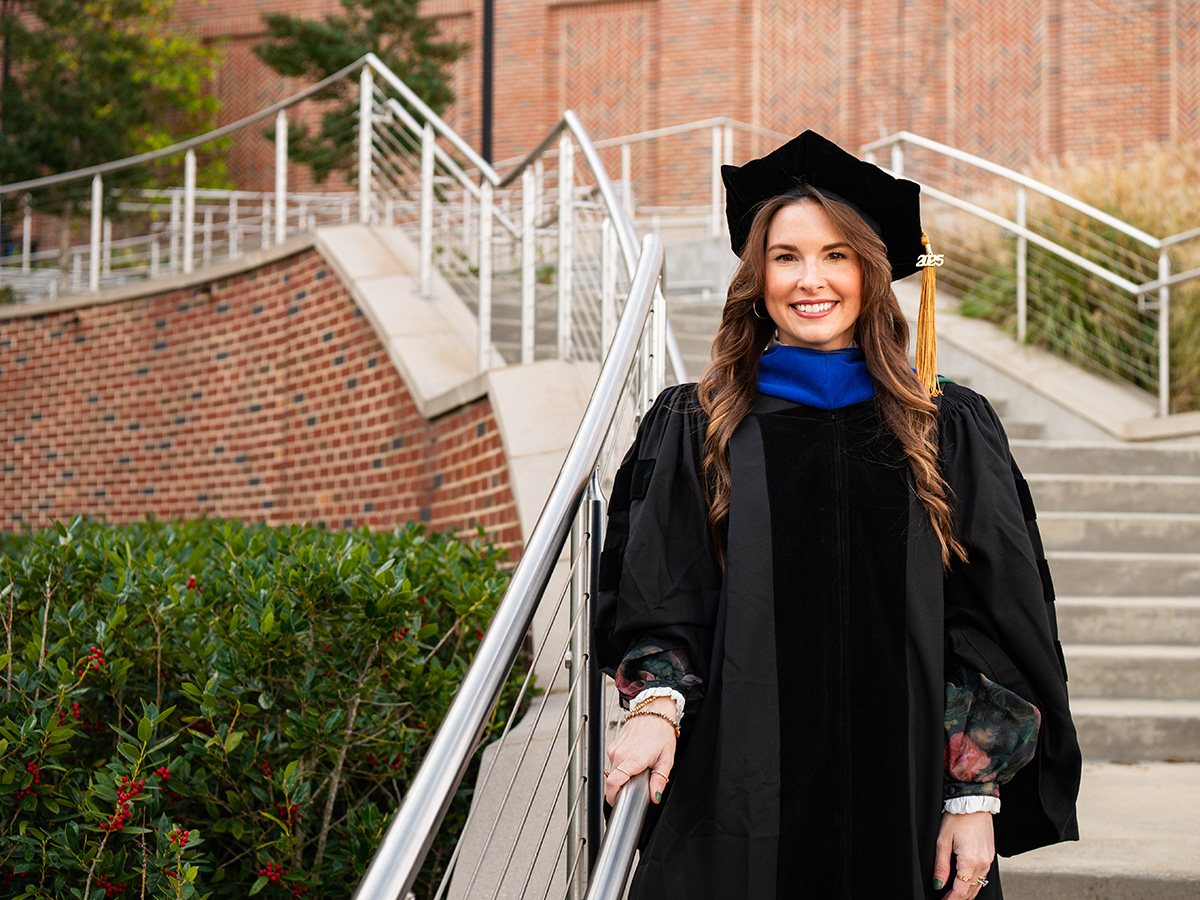Photos by Nik Layman
Making Connections
Jim Sokol and Lydia Cheney
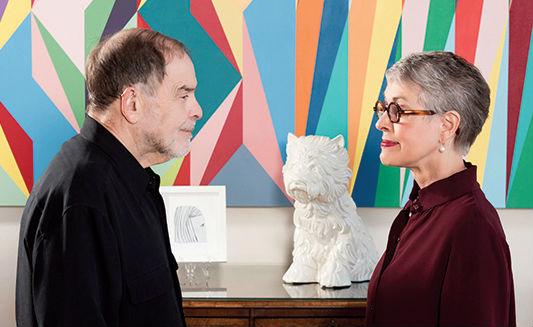 Jim Sokol and Lydia CheneyJim Sokol and Lydia Cheney’s ties to UAB are so strong—and go back so many years—that it takes them both a few minutes to untangle exactly where the strands start.
Jim Sokol and Lydia CheneyJim Sokol and Lydia Cheney’s ties to UAB are so strong—and go back so many years—that it takes them both a few minutes to untangle exactly where the strands start.
“Let’s see, I’ve been collecting artwork by the faculty in the Department of Art and Art History for a long time,” Sokol says. “I bought some of John Dillon’s work, he’s now retired. That was a long, long time ago. And Sonja Rieger’s work, and Gary’s Chapman’s work, and Edith Frohock.”
Sokol and Cheney have been longtime collectors of contemporary and outsider art, and over the years have amassed a jaw-dropping collection of pieces from Jeff Koons, Willie Cole, Enrique Martínez Celaya, Frank Fleming, Chris Clark, Mose T, and many more.
“About 15 years ago I decided to audit some art history courses at UAB because at some point I said, ‘We’re buying this stuff and it would help if I knew something about it.’ I had a dangerously small amount of knowledge about art,” Sokol says.
“You also took classes with Katherine McIver,” Cheney points out.
“That’s right. She taught Italian Renaissance; I audited everything she taught,” Sokol says.
“And Jim always went to most of the shows at the Visual Arts Gallery (part of the Department of Art and Art History), that Brett Levine used to curate,” Cheney adds.
It’s not unusual for the couple to finish each other’s sentences, or elaborate on a point the other has missed. Together for 26 years and married for 13, they have developed a unique balance of independence and deep connection that allows them to pursue their personal passions (they are often drawn to different artists and projects) while still maintaining an exceptional closeness. They are different, yet complement each other: where Sokol is more reserved and thoughtful, Cheney is outgoing and effervescent. But it’s a combination that clearly works, and is based in their love for one another and their shared passion for art—and UAB.
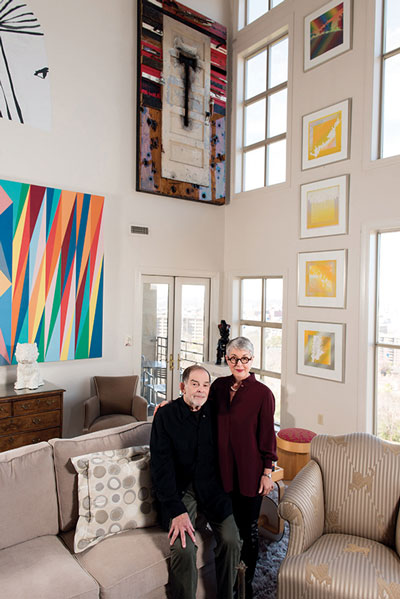 The Sokol-Cheney home includes pieces by Amy Pleasant (black-and-white portrait, top left), Odili Donald Odita (brightly colored geometrics, below left), Jeff Koons (puppy vase on cabinet), Radcliffe Bailey (door with axe, top), and June Wayne (yellow prints).
The Sokol-Cheney home includes pieces by Amy Pleasant (black-and-white portrait, top left), Odili Donald Odita (brightly colored geometrics, below left), Jeff Koons (puppy vase on cabinet), Radcliffe Bailey (door with axe, top), and June Wayne (yellow prints).
Cheney’s connection to the institution goes back to 1991, when she worked in the UAB Center for Aging, a position she held for six years. From there she moved to the UAB Comprehensive Cancer Center, where she worked for another six years. It was her connections in the medical school and health system that led the couple to assist with a new art project at UAB—ArtBlink, the Cancer Center’s biggest fundraising event.
“I guess we helped them find the first artists for ArtBlink,” Cheney says, looking at Sokol. “We identified several,” he confirms, listing Amy Pleasant and Karen Graffeo before Cheney jumps in to add Lonnie Holley and Darius Hill’s names to the list.
The threads of connections between the couple and UAB continued to be tightly woven. When senior administrators began to develop a concept for a UAB art institute, Sokol and Cheney were early supporters.
Cheney says. “[Former School of Arts and Humanities Dean] Bert Brower deserves great credit for what became the Abroms-Engel Institute for the Visual Arts,” Cheney says. “He cultivated the relationships, particularly with Marvin and Ruth Engel, that helped get the project off the ground. Hal and Judy Abroms were also a key component for the Institute."
“And [President] Ann Reynolds was also interested in art,” Sokol adds.
“Yes, Jim loved the work of Joel Seah, a BFA student at UAB,” Cheney says. “We hosted a social here that featured his work, and President Reynolds came. It was an early iteration of what is now the Friends of the Department of Art and Art History, and really the first salon that we hosted.”
Since then, the Sokol-Cheney home has become something of a nexus for artists and faculty members in the Department of Art and Art History, as well as for AEIVA staff. And the couple’s vast connections in the contemporary art world have inspired some of AEIVA’s landmark exhibitions, which have often included pieces from the couple’s personal collection.
“Lydia collects Leslie Wayne, and Leslie was the artist for ‘Mind the Gap,’ one of the first shows at AEIVA,” Sokol recalls. “That was before [Chair] Lauren Lake was hired, so we reached out to [faculty member] Gary Chapman who said, ‘As soon as our new chair gets here, we’ll talk about it.’ So that’s how that came to be. Really anytime we host artists here in our home, we take them to campus and show them AEIVA. They are just blown away. Not long ago we invited the artist Titus Kaphar to stay with us and we took him to campus for a tour. As soon as he saw AEIVA he said, ‘I want to have a show here,’ and so he’s going to be exhibiting there this fall.”
“We have really seen the evolution of both the department and of AEIVA, and both are very important to UAB and to the whole community,” Cheney says. “The department has its focus on students and faculty: the academic part. The Institute really has the engagement with people from all over, and both have put UAB on the map. These are things the university can be proud of.”
Sokol agrees. “And the galleries that represent these artists—they list UAB and AEIVA in their bios. It makes us credible.”
“We can’t say enough about the people we’ve come to know over the years,” Cheney continues. “Lauren has done an amazing job with the department, and we just think the world of her. Curator John Fields has been an excellent curator at AEIVA and has some incredible ideas for future programs. And of course Lisa [Tamiris] Becker, was a wonderful founding director for AEIVA. I admired her intellect and her appreciation for Enrique Martínez Celaya, whose work I love. When I realized Lisa and I had that connection, I thought I had died and gone to heaven.“
When asked what they envision for the future of the arts at UAB, Cheney doesn’t hesitate. “Jim and I hope that the arts at UAB would receive support from the highest echelons. The AEIVA building itself and the vision of Dean Palazzo are both impressive.”
“We couldn’t imagine life without UAB,” Sokol says.
Meeting Needs
Lee and Brenda Baumann
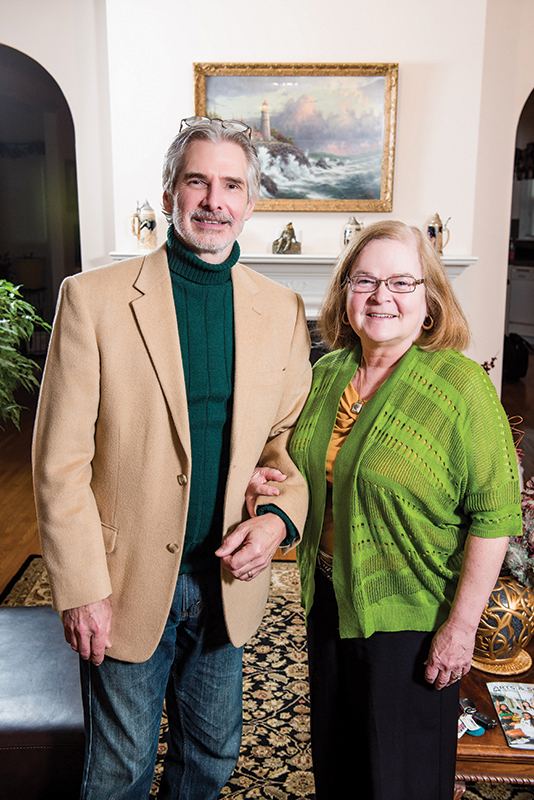 Lee and Brenda Baumann at their home. Perhaps it's no surprise that two physicians would choose to fund student scholarships. “Most people go into medicine to help humankind,” says Dr. Lee Baumann. “Our scholarships are really an offshoot of that.”
Lee and Brenda Baumann at their home. Perhaps it's no surprise that two physicians would choose to fund student scholarships. “Most people go into medicine to help humankind,” says Dr. Lee Baumann. “Our scholarships are really an offshoot of that.”
Lee and his wife Brenda have endowed the God at the Speed of Light Scholarship in the College of Arts and Sciences, which funds four students in need of financial assistance. “It’s based purely on financial need,” Lee says. “To us, you don’t have to be a Rhodes scholar or even show lots of community service. We know that many students are working while they’re going to school, and that can have an impact on their GPA or their ability to participate in extracurricular activities. We want to help any student who needs it.”
Though the roots of the Baumanns’ altruism were established in medical school at the University of Southern Illinois, their generosity flourished after they moved to Birmingham. The couple was living in Pennsylvania, where Lee, who had a background in internal medicine and geriatrics, was working in administrative medicine. When he had the opportunity to take a position with Complete Health in Birmingham in 1992, he and Brenda relocated.
"We all have to participate to give opportunities to young adults." — Dr. Brenda Baumann
While Lee was establishing himself with his new company, Brenda took a job as a team physician with UAB Athletics, a position she held—along with her work in Student Health Services—for more than two decades. “It was such a positive experience for me,” Brenda says. “Through Student Health, I got to meet so many students, including international graduate students. To interact with such bright people at the start of their career was so rewarding. Spending time with them, you learned what they were doing and what they hoped to accomplish. I might be at a basketball practice in the morning and then treat a biomedical engineering student in the afternoon. I got to really experience the whole breadth of UAB.”
Lee left administrative medicine in 1998 and turned to writing, inspired by his own spiritual journey and his longstanding curiosity about the intersection of faith and science. His first book, “God at the Speed of Light,” argues that science and spirituality are two sides of the same coin. And its title is the name the Baumanns have given to their scholarships, which they’ve established at UAB, Auburn University, the University of Alabama, Mississippi State University, Southern Mississippi University, and the University of Mississippi. They’ve also endowed scholarships at Southern Illinois University and in Cape Town, South Africa.
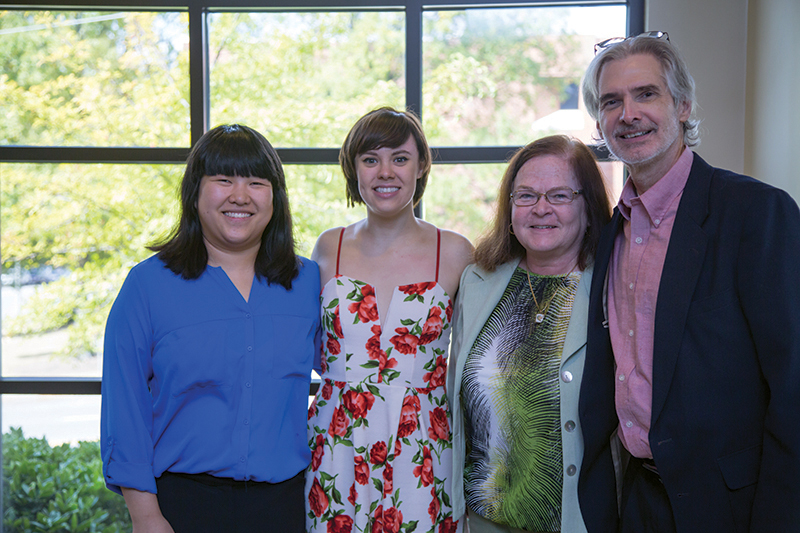 Lee and Brenda Baumann with Stephanie (Gracie) Giang and Alexandra Fry at the 2015 Scholarship and Awards Luncheon. “We didn’t want to put anything in our own name,” Lee says. “I wanted to acknowledge something beyond me.”
Lee and Brenda Baumann with Stephanie (Gracie) Giang and Alexandra Fry at the 2015 Scholarship and Awards Luncheon. “We didn’t want to put anything in our own name,” Lee says. “I wanted to acknowledge something beyond me.”
Although Lee says he was the catalyst for starting the scholarships, he says Brenda is fully supportive of their giving. “In my years as a physician, I’ve seen a lot of people have trouble paying for their medicine, much less tuition,” she says.
“And we both know that the future of the world is based in education,” Lee says.
“Yes, that’s right,” Brenda agrees. “Looking back at my own education, I came from a middle-class family and my scholarships were a huge help to my parents,” Brenda says. “If I had not had those opportunities I would have had to work a lot harder to pay for my education. But now college is so much more expensive than it was then, and it’s becoming unattainable for a lot of people. We all have to participate to give opportunities to young adults.”
The couple says that they will continue to fund their scholarships in the coming years to ensure that the amount of money awarded to students can meet the costs of their education. The proceeds from Lee’s book will go toward these funds.
As for UAB, the Baumanns say that now that they’ve spent time on other campuses, they know UAB has something special.
“It’s truly one of the most diverse, international communities anywhere,” Lee says. “There’s nothing else like it.”
Maximizing Opportunity
Jane and Jim Ed Mulkin
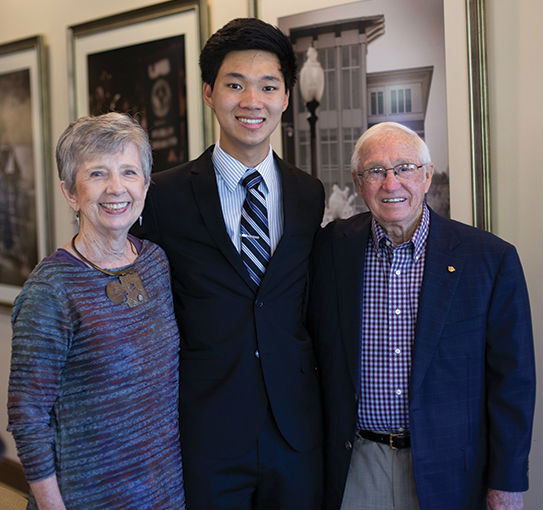 Jane and Jim Ed Mulkin with scholarship recipient Kevin Lee.There are people who let life happen to them, and then there are the people who tackle it head-on. Without a doubt, Jane and Jim Ed Mulkin are in the latter group. Curious, passionate, entrepreneurial and hardworking, this couple, married for almost 62 years, see each day as an opportunity to learn.
Jane and Jim Ed Mulkin with scholarship recipient Kevin Lee.There are people who let life happen to them, and then there are the people who tackle it head-on. Without a doubt, Jane and Jim Ed Mulkin are in the latter group. Curious, passionate, entrepreneurial and hardworking, this couple, married for almost 62 years, see each day as an opportunity to learn.
Within minutes of arriving at the Mulkins’ 100-acre farm in Tuscaloosa County, guests are greeted with hugs, big smiles, and lots of questions: Where are you from? Where did your parents grow up? Are you kin to the so-and-sos? How long have you had your job? What did you do before that? And on and on…the questions keep coming as the couple explores who you are and what you think. They are excited to show you around the house and surrounding land, but they are just as excited to learn something new. They are joyful, positive, and well ... happy.
Jim Ed takes us on a tour of their land in a six-seat golf cart, with Jane riding in the rear-facing back seat. As we circle the property, Jane calls out the names of native plants while Jim Ed narrates how he, his children and grandchildren built structures and memories along the banks of Rockcastle Creek. Every turn brings a new tale: the funny “Mulkin Falls” sign his granddaughters made next to the slightest spill of water, the swinging bridge the couple deftly traverses, the two ancient beech trees, and the time Jane decided to don a wetsuit and walk in the water until she couldn’t climb out.
“The wet suit had gotten so tight I couldn’t bend my knees!” Jane laughs. “Jim Ed had to come lasso me and haul me up onto the bank.”
They are collectors of memories and stories. But they are also collectors of folk and outsider art, primitive furniture, Alabama pottery, textiles, old tools and even fire-fighting equipment.
The farmhouse and outbuilding are filled with these items, but the Mulkins assure us that there is much more in their Bessemer home. Jim Ed was born and raised in Bessemer and was a football star at Sewanee before joining the Air Force and receiving a deployment to Okinawa during the Korean War. While he was in college he’d noticed Jane, who lived in in the nearby mining community of Woodward, Alabama, and resolved to marry her when he returned from the war. He did just that, and rather than become a college football coach at Johns Hopkins—his original plan—he took the munitions pay he had collected during the war and bought a junkyard in Bessemer. He converted that junkyard into an auto parts store called Mulkin Auto and eventually opened seven locations across the Birmingham metro area before retiring. Jane, who was young when she married Jim Ed, stayed home to raise their three sons.
“But when our youngest son started Tulane,” I went back to school to get my college degree,” she says. “I majored in literature and art history at UAB and I just loved every minute of it. And the thing that impressed me most was that I had always been in my cocoon, my own insulated world, but UAB opened my eyes to all of the other kinds of people in the world I had never known about. These young people had families but they were working and going to school at the same time. It was taking everything I had to just go to school—my kids were all grown. I was so impressed by them.”
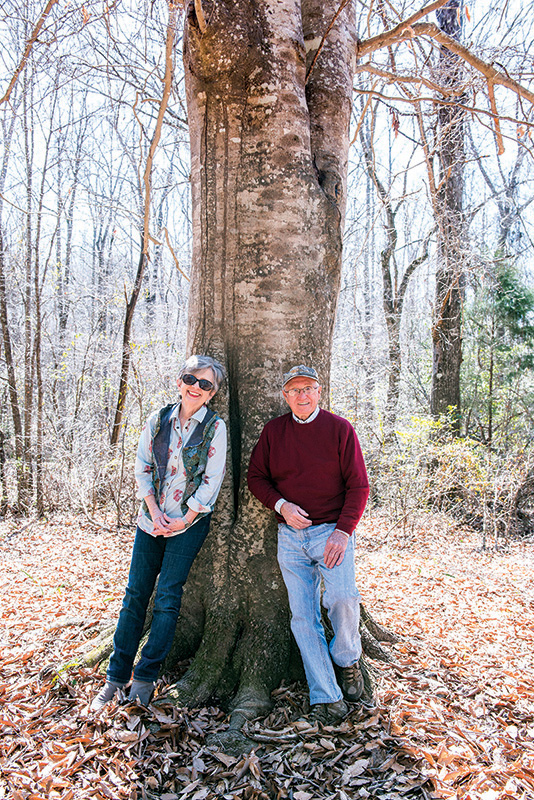 A moment in the writing lab further changed Jane’s worldview.
A moment in the writing lab further changed Jane’s worldview.
“I was working with a student named Curtis, and he was just trying to pass,” she recalls. “He was struggling with his paper and I said, ‘What if you wrote about something you’re passionate about? He said, ‘I’m passionate about mining. I work in the coal mines and then I drive in at night to go to class.’ And I just had tears in my eyes. Here was this young man who worked in the mines during the day but still made the effort to get through college and graduate with new skills for his future. He made a C in that class and I was so excited for him.”
The moment inspired the couple to establish the Jane White Mulkin Endowed Scholarship in the College to help students like Curtis. “Since then we’ve loved coming to the Scholarship and Awards Luncheon every year to meet our recipient,” Jane says. “The energy and all those bright minds in the room are just so inspiring. You can see they will change the world.”
“I think that is just a great event,” Jim Ed says. “You hate to see a young person not be able to get an education.”
Jane also gave her extensive collection of antique clothing to the Department of Theatre in 2015.
“I always adored fabric and textiles because you can see the evidence of other people in the things themselves,” she says. “I had stored them at the house but I knew they would deteriorate. I talked to my son Jimbo, who connected me to a costume designer in New York, but I also loved the Theatre department at UAB. I had taken several theatre courses and one of the first classes I took gave me the courage to go on and get my degree. Giving the clothes to the department turned out to be more meaningful than I could have imagined. A lot of the clothes belonged to people I knew, people who had died. And my daughters-in-law and grandchildren had worn them in fashion shows over the years. I had so many memories. So to know the theatre department is continuing to use them is just so special.”
Back in 1955, the young Mulkins took a little bit of money and started a business. Over the decades they raised a family, assembled a collection, and established a family legacy, all with a remarkable joie de vivre and always with a curiosity to know more about the world and the people in it. As they enjoy their active retirement, they know their endowment is supporting students who they know need the same kinds of breaks they received when they were young. “We’re just interested in helping people,” Jane says.
